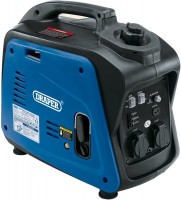How to choose a household electric generator?
We independently test the products and technologies that we recommend.

Schematically, a household electrical generator consists of an internal combustion engine that rotates the rotor of an AC electrical machine of a synchronous or asynchronous type, in fact, a generator. Such devices convert the energy of combustion of fuel into electrical energy. They are relatively small and easy to install, and the convenient handle and wheels make them easy to transport. At the output of household power generators, we get a voltage of 230 V, that is, the same as in the household electrical network. Equally popular on the market are models that give consumers 400 V.
Energy source: gasoline, diesel or gas
The fuel for an internal combustion engine is most often gasoline or diesel, less often natural gas.
.jpg) |
|
A gasoline- powered inverter generator provides output voltage 230 V with the correct sine wave |
Gasoline is the most affordable fuel, but not the cheapest. Gasoline models generate relatively expensive electricity. To generate 1 kW of power, an average of 0.5 liters of gasoline is consumed. It is known that at low temperatures they start faster and with less effort than diesel ones. The power of such a generator is small and usually does not exceed 10 kW, and its relatively small weight, compact size and low noise level make it possible to use it where a portable power source is needed.
Diesel engines themselves are more expensive than petrol models, but they have lower fuel consumption and less fuel, so this option may be more economical. At the same time, it is worth paying attention to the fact that the cost of servicing diesel engines, usually, is significantly more expensive. Diesel generators are more suitable for long-term operation. The cost of electricity generated by such devices is lower than that of gasoline analogues of the same power.
As for gas power generators, they require the installation of gas pipelines, which entails some design difficulties. But electric energy from such devices is the cheapest. They also have the lowest noise level and the lowest level of harmful emissions into the atmosphere. They are used for power supply of large objects (warehouses, airports, train stations, farms), they are practically not used in private houses.
How to choose an electric generator: power
Power is the first thing you should pay attention to. The generator of optimal power will provide the supply of electrical energy of the proper quality with deviations of the main characteristics within acceptable limits. To determine the required value, estimate the power consumption of all devices that need to be provided with electricity.
 |
|
Mainly gas powered generator used for stationary application |
Consumers of electrical energy create an active and reactive load for the electric generator. Active gives equipment that consumes as much at startup as during operation (lighting and heating equipment). For calculations, the power of these devices is summed up; you can find out the power of each electrical appliance in its passport or on the website of the manufacturer.
Household appliances, the design of which includes electromagnetic coils and capacitors, create a reactive load. A good example of such a device is a refrigerator, microwave, printer.
It is convenient to use the following rule of thumb. If a synchronous type generator is used, then its power should be 1/3 higher than the total active power of all devices simultaneously working from the generator. The power of an asynchronous type electric generator must exceed the total active load of energy consumers by 2/3. Compliance with this rule will ensure reliable power supply, as well as guarantee the operability of the generator and devices connected to it.
Synchronous type generators are the most preferred for domestic purposes. They are resistant to short-term overloads and provide high stability of the output voltage, regardless of the operation of the motor. On the other hand, they are relatively expensive and require more frequent maintenance. Synchronous generators can be used to power electrical tools, but to power welding equipment, it is better to look at models specially designed for this.
Asynchronous type generators are structurally simple, cheap and compact. Design features allow you to reliably protect them from moisture and dust. But they are less resistant to overloads and provide less stable output voltage.
Quality of electrical energy
The electric generator must generate electrical energy with minimal deviations of characteristics from permissible values. For this, modern models use an inverter. It converts the voltage in such a way that an electrical voltage of 230 V with the correct sinusoid is created at the output of the device. Inverter power generators will be an excellent backup source of electricity for computer, telecommunications or medical equipment and other types of special equipment, but there is no special need in ordinary life.
 |
| Load connection |
On the other hand, high-quality power supply is also necessary for the operation of household appliances. The automatic voltage regulator allows you to get a more even voltage and a sinusoid at the output. Some models have a voltmeter, allowing for a rough quality control.
An internal combustion engine needs to be cooled. Most household electric generators use engines with a classic air system. More expensive and advanced solutions boast water cooling, which is by far the most efficient type.
In low-cost models, manual engine start is used. More expensive ones are equipped with an electric starter, which is a battery-powered electric motor. Its presence greatly simplifies the launch process - just press the appropriate button. A very important point from a practical point of view, especially if the device will need to be turned on by a girl or wife.
The autorun system provides the ability to automatically turn on the device when loaded. This allows you to provide uninterrupted power supply, but at the same time, such solutions cost, usually, much more expensive than similar models, but without an autorun system.
To control the operation of the engine, some models are equipped with a fuel and oil level indicator, as well as an hour metre.
What else you need to pay attention to when buying
When choosing an electric generator, it is convenient to be guided by such criteria.
Articles, reviews, useful tips
All materials














